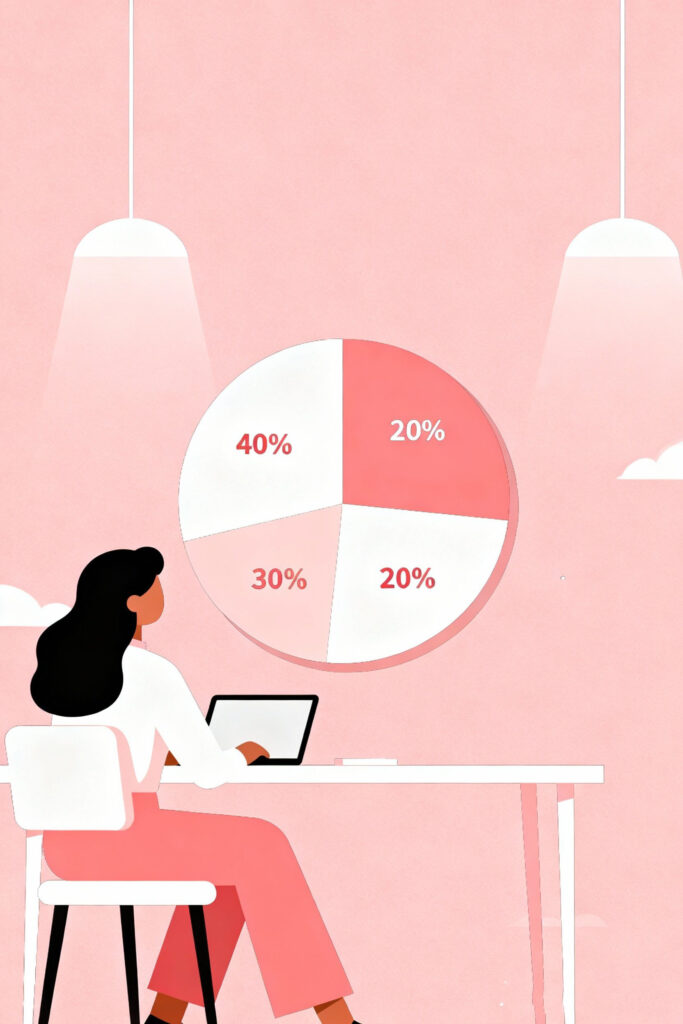If you’ve ever wondered where your paycheck disappears every month or why saving feels so hard, you’re not alone. Managing money is not as simple as it may sound but with a budget that is simple, practical, and realistic, managing money can become easier to deal with. One of the easiest and most balanced ways to budget your income is the 40-30-20-20 rule which is all about dividing your spending into 4 categories, needs, wants, savings, and paying off debt or investing. If you’re new to the 40-30-20-20 budgeting method, this article will help you explore the dynamics of the rule that is structured enough to maintain discipline and flexible enough to make it feel less overwhelming and more like something you can work with.
Understanding the 40-30-20-20 Rule

The 40-30-20-20 is a modern and more flexible approach that makes room for needs, wants, savings, and debt repayment or investments as well. The rule suggests that 40% of your income goes to your needs, 30% to wants, 20% to savings, and lastly 20% to investments or debt repayments.
This balanced system of distribution can help you prioritize your expenses, preferring needs over all other spending categories. It makes sure you cover your day-to-day necessities , save for savings, while still making room for things and activities you enjoy, debt payments if there are any, or pay your future self by investing.
Why This Rule Works for Beginners
The reason the 40-30-20-20 rule works so well for beginners is that it takes away the confusion and complexity that often comes with traditional budgeting. Instead of dealing with dozens of categories and endless sub-lists, it keeps things simple and focused by grouping all your spending into four easy-to-understand sections.
You instantly get a clear view of where your money is going, what’s necessary, what’s enjoyable, what’s being saved, and what’s helping you grow. It also helps you stay balanced between living comfortably today and preparing for tomorrow, which is something most people struggle to find. It’s less about strict restrictions and more about giving your money direction and purpose.
Breaking Down the 40%: Covering Your Essential Needs
The first 40% of your income goes toward your needs, which are the foundation of your financial life. These are the unavoidable, must-pay expenses that keep your household running such as things like rent or mortgage payments, groceries, utilities, healthcare, insurance, transportation, and basic personal care.
The idea is to make sure your essential expenses are comfortably covered without spilling over into the money you’ve allocated for wants or savings. This also helps you identify when you might be overspending on something that should be considered a want rather than a need, giving you a clearer picture of your true living costs and where adjustments may be necessary.
The 30% for Wants: Enjoying Life Without Guilt

The next 30% is reserved for your wants, which are the things that add comfort and happiness to your life, making your daily routine feel more enjoyable and less mechanical, even though they’re not necessary for survival. This portion of your budget is where you allow yourself room to breathe and enjoy the small luxuries that bring you joy, whether that’s going out for dinner with friends, taking a weekend getaway, or treating yourself to that morning coffee that starts your day on a comforting note.
What makes this budgeting rule truly practical is that it doesn’t force you to completely give up the things you love, it simply helps you manage them with balance and mindfulness, so you can indulge in them without feeling the guilt that often comes with overspending.
The 20% for Savings: Building Your Financial Cushion
The next 20% of your income should go directly into savings, which acts as your personal safety net for the future, giving you a sense of stability and reassurance no matter what life brings your way. This portion of your budget can be divided into different purposes such as an emergency fund for unexpected situations, short-term goals like buying a new car or renovating your home, and long-term goals like retirement or future investments that help you build wealth over time.
Every dollar you set aside is a step toward independence and confidence, reminding you that you’re not just earning for today but also protecting tomorrow.
The Other 20%: Paying Off Debt or Investing for Growth
The final 20% of your income is dedicated to debt repayment or investments, depending on where you are in your financial journey, and this is the part that truly helps you move forward and grow beyond simply managing expenses. If you’re dealing with debts such as credit cards, personal loans, or student loans, this portion should go toward paying them down consistently, reducing your financial burden and freeing up future income for other goals.
Once your debts are under control or completely paid off, you can then channel this same amount into investments such as mutual funds, index funds, or retirement accounts that allow your money to grow passively and steadily over time.
How to Calculate Your Income and Apply the Percentages
To make the 40-30-20-20 rule truly work in your favor, the first step is to calculate your net income, which is the actual amount you take home after taxes and deductions, giving you a realistic figure to base your budget on. Once you have that clear number, you can begin dividing it according to the rule, 40% for needs, 30% for wants, 20% for savings, and 20% for debt repayment or investments. For instance, if your take-home pay is $3,000 per month, this would mean $1,200 goes toward your needs such as rent, groceries, and bills, $900 can be comfortably spent on your wants, $600 is directed into savings, and another $600 is used to pay off debt or invest.
Adjusting the Rule to Fit Your Lifestyle
Everyone’s lifestyle, income, and priorities are different, which is why the 40-30-20-20 rule isn’t meant to be a strict plan that fits everyone the same way. It’s more like a flexible guide that you can adjust to your own life. For example, if your rent, groceries, or bills take up a bigger part of your income, you can shift the rule a little, maybe spend 45% on needs and reduce your wants to 25%, and if you don’t have any debt, you can move that extra 20% toward savings or investing to grow your money faster.
The goal is to make this rule work for you, not to feel restricted or stressed by it, but to find a balance that feels natural, realistic, and easy to maintain over time.
Common Mistakes People Make with the 40-30-20-20 Rule
A common mistake people make when following this rule is mixing up needs and wants like calling eating out a “need” or thinking that upgrading to the latest phone every year is necessary. Another mistake is forgetting to count small, regular expenses such as subscriptions, parking, or food delivery, which can quietly eat away at your budget without you noticing.
The best way to avoid these slip-ups is to stay aware and honest about your spending habits. Take a few minutes each week to review your expenses and see where your money is going. This helps you notice unhealthy patterns early and make small adjustments before they turn into bigger problems.
Tips to Stay Consistent with Your Budget
The toughest part about budgeting isn’t actually making the plan, it’s following it consistently. To make it easier, try automating your savings and debt payments so that the money is transferred automatically every month before you even get a chance to spend it.
You can also keep a simple tracker, whether it’s on paper or an app, to watch your progress and celebrate small wins along the way. Remember, consistency doesn’t mean being perfect, it means showing up and making mindful choices most of the time. Even small, steady steps add up and keep you moving closer to financial control and peace of mind.
When and How to Review or Rebalance Your Budget
Your budget isn’t something you create once and then leave untouched forever, it’s meant to grow and evolve as your life does. Over time, your income might increase, new bills might appear, or your priorities may shift, which means your budget should adjust to reflect those changes.
A smart habit is to review your budget every few months and check whether it still fits your lifestyle and goals. If you notice that you’re overspending in one area or saving less than you’d like, don’t panic or make big, overwhelming changes all at once. Instead, make small, realistic changes that you can actually stick to.
How This Rule Leads to Financial Freedom
The real beauty of the 40-30-20-20 rule lies in its balance, it gives you both structure and flexibility at the same time. It helps you cover your essential needs, enjoy the things that make life fun, and still save or invest for the future without feeling deprived.
This rule teaches you that financial control doesn’t mean giving up on happiness or comfort, it means being intentional about how you use your money. Over time, you start to feel more confident about your finances, more mindful about your spending, and more peaceful knowing that you’re not just surviving, but slowly building stability and freedom.
Conclusion
At the end of the day, the 40-30-20-20 rule is one of the easiest and most practical budgeting systems you can follow. It’s simple enough for beginners to understand, yet powerful enough to bring long-term balance to your finances. By giving every dollar a purpose and dividing your income in a thoughtful way, you’re building a foundation that brings both your present comfort and your future security. Whether you’re just starting your money journey or trying to organize your current finances, this rule helps you find clarity, balance, and calm, reminding you that good money management isn’t about strict limits, but about making your finances work for you, one intentional step at a time.
